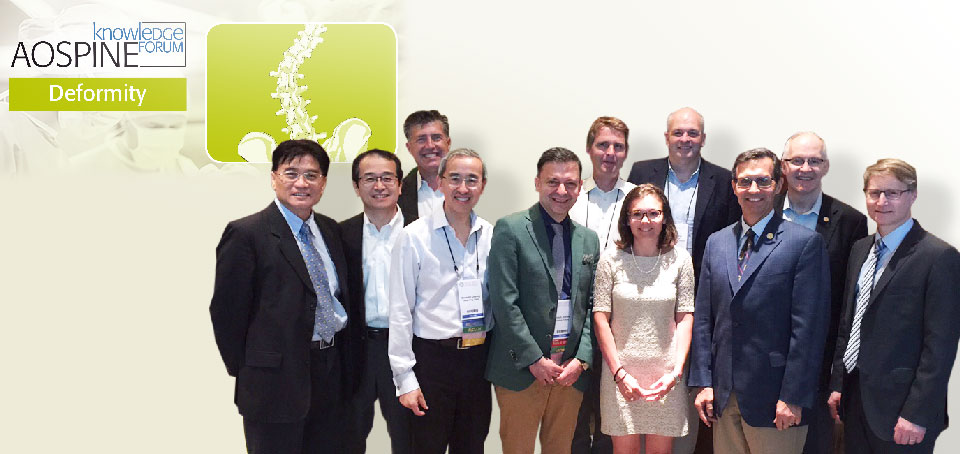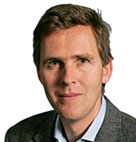feature stories
A class act—Interview with Alexander Vaccaro
Meet the AOSpine Chairperson-elect Shanmuganathan Rajasekaran
Highlights
Davos Courses 2017
Social media—friend or foe? How to manage your online reputation
A new virtual library for AOSpine Members (Spanish/Portuguese)
Educating globally—a quick guide for cross-cultural communication
Crossing borders—International Educator of the Year 2016 Juan Emmerich
Success story: regional courses in Mexico
INSIGHTS Spine is Growing Fast
AOSpine members opinion matter!

KF Deformity Steering Committee in Kuala Lumpur, Malaysia, 2015. From left to right: Young Qiu, Manabu Ito, Sigurd Berven, Kenneth Cheung, Ahmet Alanay, Marinus de Kleuver, Niccole Germscheid, Christopher Shaffrey, Lawrence Lenke, David Polly, Stephen Lewis.
The AOSpine KF Deformity: A truly international spine deformity study group
The AOSpine Knowledge Forum (KF) Deformity is entering exciting times, harvesting the results of its first six years of research. The group expects to generate several landmark papers and set the standard of care for deformity patients.
"It was like a huge breath of fresh air", chairperson Marinus de Kleuver describes the creation of KF Deformity. Global thought leaders were brought together from inside and outside AOSpine. Lawrence Lenke had been attracted by the opportunity to set up the first truly international group and became the first co-chair. "I was a bit shocked actually, let's face it!" he says remembering the "It was like a huge breath of fresh air. Global thought leaders were brought together from inside and outside AOSpine."call from the AO from Luiz Vialle. "Someone calls you with an idea to develop a global study group with guaranteed research funding. It was like a dream come true!" The interaction of diverse opinion leaders from all around the world generated exciting new ideas. "They had to talk the talk, and walk the walk. Besides academic credibility, the members had to be clinically productive", Lenke reminds. The new KFs also helped dispel concerns about AO being guided by the industrial partner, as the first AOSpine Research Commission chair and KF Deformity co-chair Kenneth Cheung adds.
At the time, AO already had a big name in trauma, but was not as well-positioned within the spine deformity community. "And while, for example, the new KF Tumor group was filling a need in oncology, we already had some strong players in the world market in deformity", de Kleuver reminds. The KF helped bridge AOSpine "The KF helps bridge AOSpine with other renowned academic communities in the field."with other renowned academic communities in the field, the most important being the Scoliosis Research Society (SRS). "There are a lot of synergies, some natural overlap, but no real duplication, because the profiles are different. Our collaborations are very important also for getting global acceptance for our outcomes."





 Kenneth Cheung shares his vision at the KF launch (Davos, Switzerland, 2011). Michael Fehlings receiving the Whitecloud Award from Christopher Shaffrey at the IMAST, Kuala Lumpur, Malaysia 2015.The clinical trial collaboration between AOSpine and SRS exceeded all expectations (Istanbul, Turkey, 2012).Lawrence Lenke at Global Spine Congress (Buenos Aires, Argentina, 2015).The AIS Consensus panel met in Hong Kong in 2013 for the final Delphi round.KF Deformity meeting in Milan, Italy, 2017 attended by most of the 8 new associate members –Saumyajit Basu, Munish Gupta, Emiliano Vialle, Ferran Pellsé, Yukihiro Matsuyama, André Luís Andújar Fernandes, Venugopal Menon and Jean Ouellet – now working closely with the Steering Committee.5 - 6<>
Kenneth Cheung shares his vision at the KF launch (Davos, Switzerland, 2011). Michael Fehlings receiving the Whitecloud Award from Christopher Shaffrey at the IMAST, Kuala Lumpur, Malaysia 2015.The clinical trial collaboration between AOSpine and SRS exceeded all expectations (Istanbul, Turkey, 2012).Lawrence Lenke at Global Spine Congress (Buenos Aires, Argentina, 2015).The AIS Consensus panel met in Hong Kong in 2013 for the final Delphi round.KF Deformity meeting in Milan, Italy, 2017 attended by most of the 8 new associate members –Saumyajit Basu, Munish Gupta, Emiliano Vialle, Ferran Pellsé, Yukihiro Matsuyama, André Luís Andújar Fernandes, Venugopal Menon and Jean Ouellet – now working closely with the Steering Committee.5 - 6<>
Creating a common language
KF Deformity research covers both adult and pediatric deformities. The studies fall under two categories: large multi-center cohort studies, generating new knowledge, and the development of classification systems and outcome sets.
Our biggest study has been Scoli-RISK-1, a highly successful collaboration with SRS, initiated shortly before the KF was set up. "This is, by far, the best existing international multicenter prospective data on the rate of neurologic complications associated with adult spinal deformity operations. The word is getting out and the results are being widely reported", Cheung describes. Another major study is PEEDS, a prospective evaluation of elderly deformity surgery. "We made a real effort to design landmark studies that were knowledge generating. For this reason, some of our publications may take a bit longer, the patient outcomes alone taking years", de Kleuver adds.
The second category of studies has so far looked at defining an international consensus on optimal treatment for spinal deformity patients – both in adolescent idiopathic scoliosis and adult spinal deformity patients. Following this global effort, the group is embarking on an intraoperative spinal cord monitoring study which will look at the role of monitoring in both pediatric and adult deformity surgeries. "Our aim is to come up with a standard of care, to find the state of the art. This study will be revolutionary for surgical teams working with complex cases", Lenke predicts. Another ground-breaking study will categorize complications in all of spine surgery, and the sorely needed results are expected by early 2018. "There is no accepted classification scheme when talking about complications. Concepts like 'major' or 'minor' are all heterogeneous. With no standards, it is difficult to compare studies or complication rates." Lenke expects huge impact from this study. "AOSpine classifications will become a standard to be proud of and a legacy for our group."
"AOSpine classifications will become a standard to be proud of and a legacy for our group."
"All these initiatives are aimed at creating a common language and framework to communicate across different parties", de Kleuver explains. "There is a myriad of outcome studies and instruments out there, everybody uses different instruments to measure their quality of care. We help bring more rationale to the options that are available."
A will to improve clinical practices
All KF Deformity studies have been led by a Steering Committee member, and the focus is on carrying out research. "One of our strengths has been that we spend so much time in clinical work, in hospitals, and doing the actual research", de Kleuver says. With the recently added eight new associate members, the group is making sure they have the right global representation. Injections of new blood broaden the talent pool and help with succession planning. "But you only invite people, who you know will deliver", de Kleuver says.
"Research is very special, and high-quality research will always be done by a small group of people. The key is to identify this group, and find other ways to involve others", Cheung continues. "All our members have great ideas. So much so, that we may have to look beyond AO funding to carry them out."
The group welcomes expectations for increased transparency and accountability, which they see leading to better quality and wider acceptance. Globalization will help spread the word, involve more surgeons, and reach more stakeholders. Cheung frames the critical measure of success he hopes to witness with KF Deformity: "Publishing in high quality journals is important and easy to measure. But to show that practice or understanding has improved because of our research? I hope that in time we can show we have achieved this."
 Marinus de Kleuver had a long career in AOSpine education before the start of KF Deformity.
Marinus de Kleuver had a long career in AOSpine education before the start of KF Deformity.
Quick facts:
- KF Deformity launched in 2011, co-chaired by Lawrence Lenke and Kenneth Cheung
- Chairperson Marinus de Kleuver currently leads a Steering Committee of 9 members; and serves as a member of the AOSpine International Research Commission
- A group of 8 new associate members represent all five AOSpine regions
- Received several awards for the Scoli-RISK-1 study, including the Hibbs Clinical Research Award at the SRS Annual Meeting 2013 (nominated in 2017, 2016, 2014); Whitecloud Award at IMAST (the International Meeting on Advanced Spine Techniques) 2016 and 2015; Best Paper Award at the Global Spine Congress 2015 (nominated 2016).
- Published 6 peer-reviewed journal articles and 70 presentations. 5 accepted manuscripts coming out shortly (September 2017)
- AOSpine Master Series, Volume 4, Adult Spinal Deformities, 2015
- AOSpine Master Series, Volume 9, Pediatric Spinal Deformities coming soon
This article is part of a series on the AOSpine Knowledge Forums. The story of the Knowledge Forums was published in the AOSpine Newsletter Issue 11. Upcoming issues will showcase more KFs and their most important study projects.
Study highlights:
- Prospectively evaluated neurologic complications associated with surgical correction in over 270 adult spine deformity patients (Scoli-RISK-1)
- Identified optimal operative care for adolescent idiopathic scoliosis patients (AIS Consensus) with the opinions from a panel of 48 spine deformity surgeons from 29 countries worldwide
- Enrolled 233 patients in the prospective evaluation of elderly deformity surgery: a prospective observational multicenter study (PEEDS)
- Formed an international consensus on the surgical management for adult spinal deformity patients (ASD Consensus) with the opinions from a panel of 53 spine deformity surgeons from 24 countries worldwide
- Defined a core outcome set for adolescent patients with a spinal deformity (COSSCO)
- For more information about the KF Deformity: www.aospine.org/kf-deformity
Newsletter 13 October 2017
Feature stories
A class act—Interview with Alexander Vaccaro
Meet the AOSpine Chairperson-elect Shanmuganathan Rajasekaran
Highlights
Davos Courses 2017
Social media—friend or foe? How to manage your online reputation
A new virtual library for AOSpine Members (Spanish/Portuguese)
Educating globally—a quick guide for cross-cultural communication
Crossing borders—International Educator of the Year 2016 Juan Emmerich
Success story: regional courses in Mexico
INSIGHTS Spine is Growing Fast
AOSpine members opinion matter!